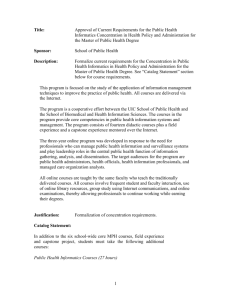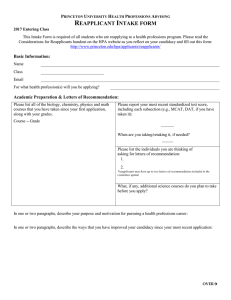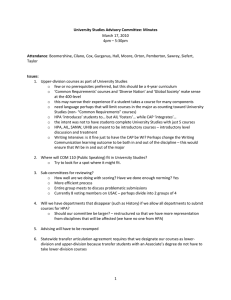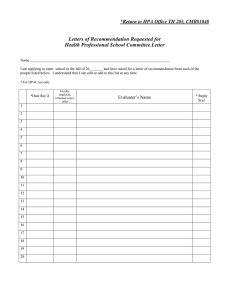Thermodynamics Exercises: Gas Laws, Atmospheric Processes
advertisement
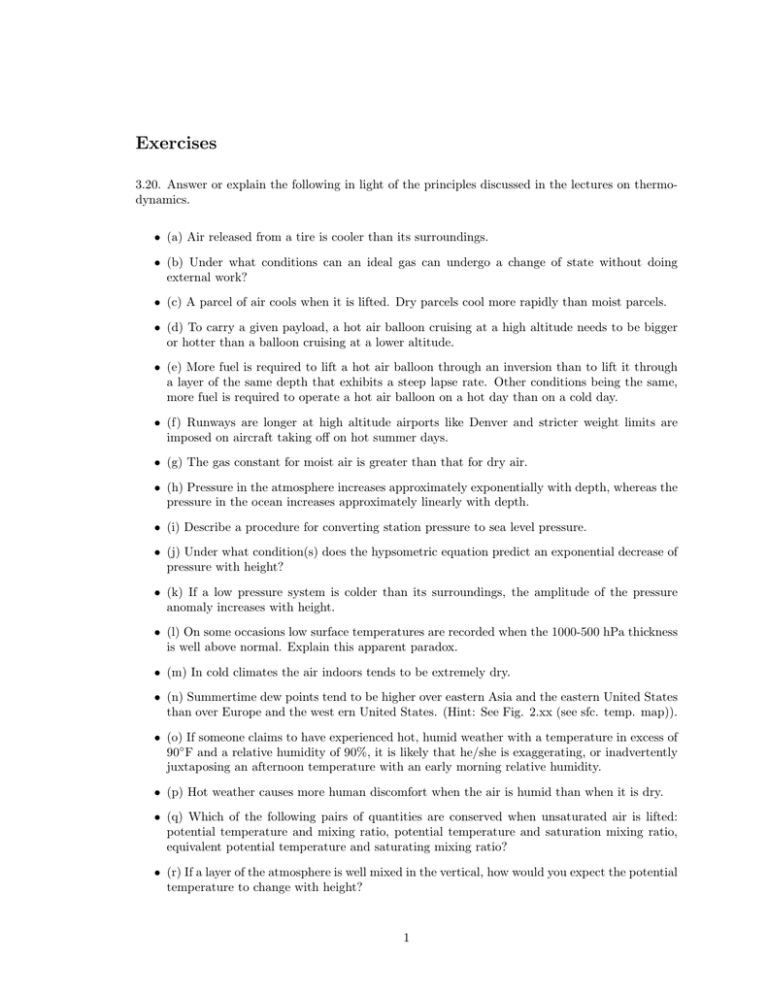
Exercises 3.20. Answer or explain the following in light of the principles discussed in the lectures on thermodynamics. • (a) Air released from a tire is cooler than its surroundings. • (b) Under what conditions can an ideal gas can undergo a change of state without doing external work? • (c) A parcel of air cools when it is lifted. Dry parcels cool more rapidly than moist parcels. • (d) To carry a given payload, a hot air balloon cruising at a high altitude needs to be bigger or hotter than a balloon cruising at a lower altitude. • (e) More fuel is required to lift a hot air balloon through an inversion than to lift it through a layer of the same depth that exhibits a steep lapse rate. Other conditions being the same, more fuel is required to operate a hot air balloon on a hot day than on a cold day. • (f) Runways are longer at high altitude airports like Denver and stricter weight limits are imposed on aircraft taking off on hot summer days. • (g) The gas constant for moist air is greater than that for dry air. • (h) Pressure in the atmosphere increases approximately exponentially with depth, whereas the pressure in the ocean increases approximately linearly with depth. • (i) Describe a procedure for converting station pressure to sea level pressure. • (j) Under what condition(s) does the hypsometric equation predict an exponential decrease of pressure with height? • (k) If a low pressure system is colder than its surroundings, the amplitude of the pressure anomaly increases with height. • (l) On some occasions low surface temperatures are recorded when the 1000-500 hPa thickness is well above normal. Explain this apparent paradox. • (m) In cold climates the air indoors tends to be extremely dry. • (n) Summertime dew points tend to be higher over eastern Asia and the eastern United States than over Europe and the west ern United States. (Hint: See Fig. 2.xx (see sfc. temp. map)). • (o) If someone claims to have experienced hot, humid weather with a temperature in excess of 90◦ F and a relative humidity of 90%, it is likely that he/she is exaggerating, or inadvertently juxtaposing an afternoon temperature with an early morning relative humidity. • (p) Hot weather causes more human discomfort when the air is humid than when it is dry. • (q) Which of the following pairs of quantities are conserved when unsaturated air is lifted: potential temperature and mixing ratio, potential temperature and saturation mixing ratio, equivalent potential temperature and saturating mixing ratio? • (r) If a layer of the atmosphere is well mixed in the vertical, how would you expect the potential temperature to change with height? 1 • (s) Which of the following quantities are conserved during the lifting of saturated air: potential temperature, equivalent potential temperature, mixing ratio, saturation mixing ratio? • (t) The frost point temperature is higher than the dew point temperature. • (u) You are climbing in the mountains and come across a very cold spring of water. If you had a glass tumbler and a thermometer, how might you determine the dew point of the air? • (v) Leaving the door of a refrigerator open warms the kitchen. (How would the refrigerator need to be modified to make it have the reverse effect?) • (w) A liquid boils when its saturation vapour pressure is equal to the atmospheric pressure. 3.21. Determine the apparent molecular weight of the Venusian atmosphere, assuming that it consists of 95% of CO2 and 5% of N2 by volume. What is the gas constant for 1 kg of such an atmosphere? (Atomic weights of C, O, and N are 12, 16, and 14, respectively.) Answer: 43.2 and 192.46 J K−1 kg−1 3.22. Typical hot air balloons used on sightseeing flights attain volumes of 3000 m3 . A typical gross weight (balloon, basket, fuel and passengers, but not the air in the balloon) on such a balloon flight is 600 kg. If the ground temperature is 20◦ C, the lapse rate is isothermal, and the balloon is in hydrostatic equilibrium at a cruising altitude of 900 hPa, determine the temperature of the air inside the balloon. Answer: 87.43◦ C 3.23. The gross weight (balloon, basket, fuel and passengers but not the gas in the balloon) of two balloons is the same. The two balloons are cruising together at the same altitude, where the temperature is 0◦ C and the ambient air is dry. One balloon is filled with helium and the other balloon with hot air. The volume of the helium balloon is 1, 000 m3 . If the temperature of the hot air balloon is 90◦ C, what is the volume of the hot air balloon? Answer: 2540 m3 3.24. Assuming an isothermal atmosphere with a temperature of −33◦ C and a surface pressure of 1000 hPa, estimate the levels at which the pressure equals 100, 10, and 1 hPa, respectively. Answer: 16.2, 32.4, and 48.6 km 3.25. A hiker sets his altimeter to the correct reading at the beginning of a hike during which he climbs from near sea level to an altitude of 1 km in 3 hours. During this same time interval the sea level pressure drops by 8 hPa due to the approach of a storm. Estimate the altimeter reading at the end of the hike. Answer: 1064 m 3.26. Using eqns. (3.26) and (3.27) show that pressure decreases with increasing height at about 1 hPa per 15 m at the 500 hPa level. 3.28 A hurricane with a central pressure of 940 hPa is surrounded by a region with a pressure of 1010 hPa. The storm is located over an ocean region. At 200 hPa the pressure anomaly vanishes (i.e., the 200 hPa surface is perfectly flat). Estimate the average temperature difference between the center of the hurricane and its surroundings in the layer between the surface and 200 hPa. 2 Assume that the mean temperature of this layer outside the hurricane is 3◦ C and ignore the virtual temperature correction. Answer: About 12◦ C 3.29. The 1000-500 hPa layer is subjected to a heat source having a magnitude of 5 × 106 J m−2 . Assuming that the atmosphere is at rest (apart from the slight vertical motions associated with the expansion of the layer) calculate the resulting increase in the mean temperature and in the thickness of the layer. [Hint: Remember that pressure is force per unit area.] Answer: 0.98 K and 20 m 3.30. The 1000-500 hPa thickness is predicted to increase from 5280 to 5460 m at a given station. Assuming that the lapse rate remains constant, what change in surface temperature would you predict? Answer: 8.9◦ C 3.31 Calculate the work done in compressing isothermally 2 kg of dry air to one-tenth of its volume at 15◦ C. Answer: 3.8 × 105 J 3.33 (a) Prove that when an ideal gas undergoes an adiabatic transformation pV γ = constant, where γ is the ratio of the specific heat at constant pressure (cp ) to the specific heat at constant volume (cv ). [Hint: Use (3.1) and (3.48) in (3.44).] (b) 7.50 cm3 of air at 17◦ C and 1000 hPa is compressed isothermally to 2.50 cm3 . The air is then allowed to expand adiabatically to its original volume. Calculate the final temperature and final pressure of the gas. Answer: 86 2 C and 643 hPa 3.34 Calculate the change in enthalpy when 3 kg of ice at 0◦ C is heated to liquid water at 40◦ C. (The specific heat at constant pressure of liquid water (in J K1 kg 1) at K is given by = 4183 9 + 0 1250 .) Answer: 1 51 106 J 3.36. The pressure and temperature at the levels at which jet aircraft normally cruise are typically 200 hPa and −60◦ C. Use a thermodynamic diagram (tephigram) to estimate the temperature of this air if it were adiabatically compressed to 1000 hPa. Compare your answer with an accurate computation. 3.38. A person perspires. How much liquid water (as a percentage of the mass of the person) must evapourate to lower the temperature of the person by 5◦ C? (Assume that the latent heat of evapouration of water = 2 5 106 J kg 1, and the specific heat of the human body = 4 2 103 J K 1 kg 1.) Answer: 0.84% 3.39* Twenty liters of air at 20 C and a relative humidity of 60compressed isothermally to a volume of 4 liters. Calculate the mass of water condensed. The saturation vapour pressure of water at 20 C is 23 hPa. (Density of air at 0 C and 1000 hPa is 1.28 kg m 3.) 3 Answer: 0.14 g 3.40 If the specific humidity of a sample of air is 0.0196 at 30 C, find its virtual temperature. If the total pressure of the moist air is 1014 hPa, what is its density? Answer: 33.7 C and 1.15 kg m 3 3.41 If water vapour comprises 1% of the volume of the air (i.e., if it accounts for 1% of the molecules in air), what is the virtual temperature correction? Answer: Tv − T ≈ 1 K 3.42 A parcel of moist air has a total pressure of 975 hPa and a temperature of 15◦ C. If the mixing ratio is 1.80 g kg−1 , what are the water vapour pressure and the virtual temperature? Answer: 2.81 hPa and 15.3◦ C 3.43 A meteorological station is located 50 m below sea level. If the surface pressure at this station is 1020 hPa, the virtual temperature at the surface 15◦ C, and the mean virtual temperature for the 1000-500 hPa layer is 0◦ C, compute the height of the 500 hPa pressure level above sea level at this station. Answer: 5.654 km 3.44* 3.45 Four grams of liquid water condense out of 1 kg of air during a moist-adiabatic expansion. Show that the internal energy associated with this amount of liquid water is only 2.4% of the internal energy of the air. 3.46 The current mean air temperature at 1000 hPa in the tropics is about 25◦ C and the lapse rate is close to saturated adiabatic. Assuming that the lapse rate remains close to saturated adiabatic, by how much would the temperature change at 250 hPa if the temperature in the tropics at 1000 hPa were to increase by 1◦ C (Hint: Use a tephigram). Answer: About 6.7◦ C 3.47 An air parcel at 1000 hPa has an initial temperature of 15◦ C and a dew point of 4◦ C. Using a tephigram, • (a) Find the mixing ratio, relative humidity, wet-bulb temperature, potential temperature, and wet-bulb potential temperature of the air. • (b) Determine the magnitudes of the parameters in (a) if the parcel rises to 900 hPa. • (c) Determine the magnitudes of the parameters in (a) if the parcel rises to 800 hPa. • (d) Where is the lifting condensation level? Answer: (a) 5.1 g/kg, 47%, 9.3◦ C, 288 K, 9.3◦ C; (b) 5.1 g/kg, 75%, 4.5◦ C, 288 K, 9.3◦ C; (c) 4.3 g/kg, 100%, −1.0◦ C, 290 K, 9.3◦ C; (d) 847 hPa 4
